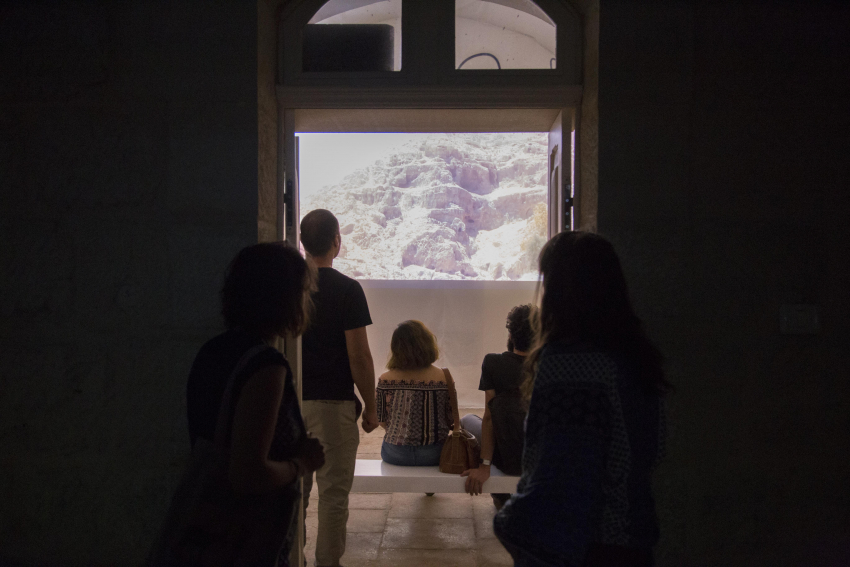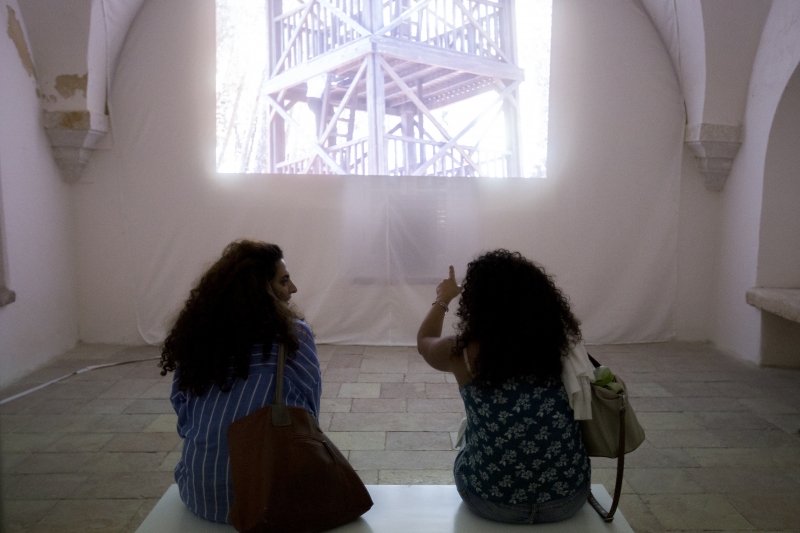
The rose-ringed parakeet (Psittacula krameri) was the theme of the art video installation Lurking Green. Over three days, 13-15 June 2017, the A. M. Qattan Foundation (AMQF) screened the video at the Al-Sa’ House (Beit il Saa’) in the old city of Ramallah. Lurking Green was exhibited in the context of /si:n/ Festival for Video Art and Performance. Filmmakers Ramzi Maqdisi and Najwa Mubarki implemented the idea of Curator Yazid Anani, Director of the AMQF Public Programme.
Also known as the ring-necked parakeet, this bird is native of the tropical areas of Africa. Having adapted so quickly to our Palestinian habitat and climate, the rose-ringed parakeet is often perching in conifers, eucalyptus and fruit trees found in our gardens and orchards.

Four videos were screened in four separate rooms. Two videos showed scenes of the rose-ringed parakeet in the 1948 territory and others in the 1967 territory. The other two videos featured an interview with the Director of the Visitors’ Centre at the Mikveh Israel Agricultural School. The last video includes interviews with a number of Palestinian ornithologists and pet shop keepers.
The earliest known fact about the release of rose-ringed parakeets in our environment goes back to the 1950s, when staff from the Mikveh Israel Agricultural School near Tel Aviv released a flock of these birds into the wild.
The Israelis claim that the rose-ringed parakeet migrated from Africa and became part of the local habitat. According to the Israeli narrative, the bird does not threaten the environment. Palestinians provide a different version about the way rose-ringed parakeets have existed in Palestine. The Palestinian narrative confirms that the bird has caused severe damage to native birds in the region. In addition to other negative consequences, the rose-ringed parakeet feeds on and destroys agricultural crops.
“At first, the theme was strange. For me, however, I think that this bird is another face of the occupation. It is not part of Palestine’s culture and environment,” Maqdisi described his experience in this work.

“It was important for me. To try and draw public attention to think about things that seem little and unclear in our daily lives… I think that our current deteriorating situation is partly caused by inattention to such small details,” Maqdisi continued.
On the idea of the exhibition, Anani relates: “When I saw the rose-ringed parakeet for the first time, I thought it was an escaped pet bird. When I saw it frequently, I decided to do an in-depth research about the bird because it was strange to the Palestinian environment. That was the origin of the idea. Rather than using written research material, I decided to use video art in my research and screen the film at the /si:n/ Festival.”
“The fact that this bird has threatened, displaced and aggressively occupied existing nesting cavities of native birds is an allegory of the occupation. At the same time, a neoliberal consumerist culture is reflected by selling the bird in pet shops and changing the social fabric of the Palestinian society,” Anani concluded.
In his comment on the video art installation, Palestinian filmmaker Kamal al-Ja’fari said: “I liked the idea. In general, few works address nature. We have a weird relationship with nature. It has not been an object of research in works of art. Regarding this bird, the work shows how Zionism has dealt with it, allowing room for imagination by research into the origin of the bird.”
The 5th edition of /si:n/ Festival for Video Art and Performance ran for four days, from 12 to 15 June 2017. The festival was organised in partnership between cultural and artistic institutions in the central Palestinian cities of Jerusalem, Ramallah, Bethlehem and Gaza. A selection of video art installations, performances and film screenings by noted local and international artists were exhibited in these cities.
